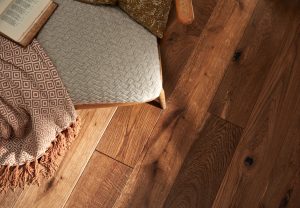Engineered hickory flooring is a versatile and durable option made by layering a real hardwood hickory veneer over a plywood or high-density fiberboard (HDF) core. This construction offers the look and feel of solid hickory with enhanced stability and moisture resistance, making it suitable for areas where traditional hardwood may not perform as well, such as basements or rooms with radiant heating systems.

How It’s Made
Engineered hickory flooring consists of multiple layers, typically with a hickory hardwood top layer bonded to a core of cross-laminated plywood or HDF. This layered structure minimizes natural wood expansion and contraction caused by humidity or temperature fluctuations.
Top Veneer
The top layer is real hickory wood, available in various grades and finishes. It determines the visible appearance, including grain pattern, knots, and natural color variation. Depending on thickness, the veneer may allow for sanding and refinishing in the future.
Core Layers
The core layers are made of plywood or HDF, arranged in a cross-grain configuration to provide structural stability. This prevents warping and cupping over time and allows installation in environments where solid hardwood might fail.
Advantages Over Solid Hardwood
While solid hickory is known for its hardness and distinctive character, engineered hickory flooring provides additional benefits in terms of installation flexibility and performance.
Dimensional Stability
Engineered hickory is less likely to expand, contract, or warp due to moisture or temperature changes, making it ideal for humid climates or rooms with fluctuating environmental conditions.
Installation Versatility
This flooring can be installed using glue-down, nail-down, or floating methods, and works over concrete slabs and radiant heat systems. It can be used in basements, kitchens, and other moisture-prone areas where solid hardwood is not recommended.
Visual Appeal and Customization
Engineered hickory flooring offers a wide range of aesthetic options, from rustic and hand-scraped to sleek and modern.
Finish and Texture
Buyers can choose from prefinished or site-finished planks, with options like matte, satin, or glossy finishes. Textures include smooth, wire-brushed, or distressed surfaces, each providing a unique feel and style.
Color Selection
Natural hickory varies from pale blond to warm brown tones, often within the same plank. Engineered versions may be stained to create more uniform or customized appearances, such as gray, espresso, or whitewashed finishes.
Longevity and Maintenance
With proper care, engineered hickory flooring can last for decades, offering both beauty and function over time.
Cleaning and Upkeep
Daily sweeping or vacuuming and occasional damp mopping are enough to keep it clean. Avoid excessive moisture and harsh cleaners to preserve the finish. Protective pads under furniture help reduce scratching.
Refinishing Potential
The ability to refinish depends on the thickness of the top veneer. Higher-end products may allow sanding and refinishing once or twice, extending their life span and allowing for aesthetic updates.
Cost and Value
Engineered hickory flooring provides a balance between affordability and performance, especially when compared to solid hardwood.
Pricing Range
Prices vary based on veneer thickness, core material, finish type, and brand. Entry-level options start around $3 per square foot, while premium styles with thick veneers and specialty finishes can reach $8–$10 per square foot.
Value for Homeowners
This flooring option delivers solid resale value thanks to its hardwood look, long-term durability, and wide design appeal. It’s a practical investment for families seeking lasting style without the drawbacks of solid wood in challenging environments.




